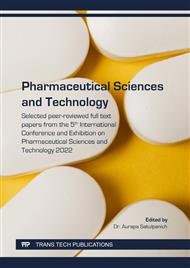[1]
R. Subramanian, M. Z. Asmawi, A. Sadikun, A bitter plant with a sweet future? A comprehensive review of an oriental medicinal plant: Andrographis paniculata, Phytochem. Rev. 11(2011) 39-75.
DOI: 10.1007/s11101-011-9219-z
Google Scholar
[2]
CC. Yen, YK. Liang, CP. Cheng, MC. Hsu, YT.Wu, Oral Bioavailability Enhancement and Anti-Fatigue Assessment of the Andrographolide Loaded Solid Dispersion, Int J Mol Sci. 21(2020) 1-18.
DOI: 10.3390/ijms21072506
Google Scholar
[3]
R. Sari, D. Setyawan, D. Retnowati, R. Pratiwi, Development of Andrographolide‑chitosan Solid Dispersion System: Physical Characterization, Solubility, and Dissolution Testing, Asian J. Pharm. 13(2019) 5-9.
Google Scholar
[4]
R. Sari, M.L.L. Sugiarto, W. Amirah, H. Yusuf, The effect of chitosan type and concentration on physical characteristics and drug release behavior of andrographolide-chitosan microparticles prepared by ionic gelation – freeze drying, Proceedings of ICoAPS. (2018) 60-68.
DOI: 10.2139/ssrn.3461443
Google Scholar
[5]
M. He, Z. Qin, X. Liang, X. He, B. Zhu, Z. Lu, et al, A pH-responsive mesoporous silica nanoparticles-based drug delivery system with controlled release of andrographolide for OA treatment, Regen. Biomater. 8(2021) 1-10.
DOI: 10.1093/rb/rbab020
Google Scholar
[6]
R. Sari, A. Widyawaruyanti, F.B.T. Anindita, S.K. Astuti, D. Setyawan, Development of Andrographolide-Carboxymethyl Chitosan Nanoparticles: Characterization, in vitro Release and in vivo Antimalarial Activity Study, Turk J Pharm Sci. 15(2018) 136-141.
DOI: 10.4274/tjps.53825
Google Scholar
[7]
P. Tran, Y.C. Pyo, D.H. Kim, S.E. Lee, J.K. Kim, J.S. Park, Overview of the Manufacturing Methods of Solid Dispersion Technology for Improving the Solubility of Poorly Water-Soluble Drugs and Application to Anticancer Drugs, Pharmaceutics. 11(2019) 1-26.
DOI: 10.3390/pharmaceutics11030132
Google Scholar
[8]
S. Alshehri, S.S. Imam, A. Hussain, M.A. Altamimi, N.K. Alruwaili, F. Alotaibi, et al, Potential of solid dispersions to enhance solubility, bioavailability, and therapeutic efficacy of poorly water-soluble drugs: newer formulation techniques, current marketed scenario and patents, Drug Deliv. 27(2020) 1625-1643.
DOI: 10.1080/10717544.2020.1846638
Google Scholar
[9]
Y. Ma, Y. Yang, J. Xie, J. Xu, P. Yue, M. Yang, Novel nanocrystal-based solid dispersion with high drug loading, enhanced dissolution, and bioavailability of andrographolide, Int J Nanomedicine. 13(2018) 3763-3779.
DOI: 10.2147/ijn.s164228
Google Scholar
[10]
K.S. Sharma, J. Sahoo, S. Agrawal, A. Kumari, Solid dispersions: A technology for improving bioavailability, J. anal. pharm. res. 8(2019) 127-133.
DOI: 10.15406/japlr.2019.08.00326
Google Scholar
[11]
S.V. Bhujbal, B. Mitra, U. Jain, Y. Gong, A. Agrawal, S. Karki, et al, Pharmaceutical amorphous solid dispersion: A review of manufacturing strategies, Acta Pharm Sin B. 11(2021) 2505-2536.
DOI: 10.1016/j.apsb.2021.05.014
Google Scholar
[12]
A. Kauppinen, J. Broekhuis, N. Grasmeijer, W. Tonnis, J. Ketolainen, H.W. Frijlink, et al, Efficient production of solid dispersions by spray drying solutions of high solid content using a 3-fluid nozzle, Eur J Pharm Biopharm. 123(2018) 50-58.
DOI: 10.1016/j.ejpb.2017.11.009
Google Scholar
[13]
R.H. Dave, A.D. Patel, E. Donahue, H.H. Patel, To evaluate the effect of addition of an anionic surfactant on solid dispersion using model drug indomethacin, Drug Dev Ind Pharm. 38(2012) 930-939.
DOI: 10.3109/03639045.2011.633264
Google Scholar
[14]
S.P. Chaudhari, R.P. Dugar, Application of surfactants in solid dispersion technology for improving solubility of poorly water soluble drugs, J Drug Deliv Sci Technol. 41(2017) 68-77.
DOI: 10.1016/j.jddst.2017.06.010
Google Scholar
[15]
A. Mahajan, N. Surti, P. Patel, N. Gheewala, A. Patel, D. Shah, Optimization of formulation and process variables using central composite design for the production of nevirapine spray dried solid dispersion, Dry. Technol. (2021) 1-14.
DOI: 10.1080/07373937.2021.1874408
Google Scholar
[16]
Z. Izadiyan, M. Basri, H.R. Fard Masoumi, R. Abedi Karjiban, N. Salim, K. Shameli, Modeling and optimization of nanoemulsion containing Sorafenib for cancer treatment by response surface methodology, Chem Cent J. 11(2017) 21-29.
DOI: 10.1186/s13065-017-0248-6
Google Scholar
[17]
H. Ahn, Central Composite Design for the Experiments with Replicate Runs at Factorial and Axial Points, Ind. Eng. Manag. (2015) 969-979.
DOI: 10.1007/978-3-662-47200-2_101
Google Scholar
[18]
C. Liu, K.G.H. Desai, X. Tang, X. Chen, Drug Release Kinetics of Spray-Dried Chitosan Microspheres, Dry. Technol. 24(2007) 769-776.
DOI: 10.1080/03602550600685325
Google Scholar
[19]
C. Mircioiu, V. Voicu, V. Anuta, A. Tudose, C. Celia, D. Paolino, et al, Mathematical Modeling of Release Kinetics from Supramolecular Drug Delivery Systems, Pharmaceutics. 11(2019).
DOI: 10.3390/pharmaceutics11030140
Google Scholar
[20]
M.P. Paarakh, P.A. Jose, C. Setty, G.V.P. Christoper, Release Kinetics – Concepts and Applications, Int. J. Pharm. Technol. 8(2018) 12-20.
Google Scholar
[21]
A. Okunlola, O.L. Akindele, Application of Response Surface Methodology and Central Composite Design for the Optimization of Metformin Microsphere Formulation using Tangerine (Citrus tangerina) Pectin as Copolymer, Br. J. Pharm. Res. 11(2016) 1-14.
DOI: 10.9734/bjpr/2016/25095
Google Scholar
[22]
M. Chen, C. Xie, L. Liu, Solubility of Andrographolide in Various Solvents from (288.2 to 323.2) K, J. Chem. Eng. Data. 55(2010) 5297–5298.
DOI: 10.1021/je100344z
Google Scholar
[23]
R.J. Chokshi, H. Zia, H.K. Sandhu, N.H. Shah, W.A. Malick, Improving the dissolution rate of poorly water soluble drug by solid dispersion and solid solution: pros and cons, Drug Deliv. 14(2007) 33-45.
DOI: 10.1080/10717540600640278
Google Scholar
[24]
M. Banerjee, D. Parai, S. Chattopadhyay, S.K. Mukherjee, Andrographolide: antibacterial activity against common bacteria of human health concern and possible mechanism of action, Folia Microbiol. 62(2017) 237-244.
DOI: 10.1007/s12223-017-0496-9
Google Scholar
[25]
S. Hossain, Z. Urbi, H. Karuniawati, R.B. Mohiuddin, A. Moh Qrimida, A.M.M. Allzrag, et al, Andrographis paniculata (Burm. f.) Wall. ex Nees: An Updated Review of Phytochemistry, Antimicrobial Pharmacology, and Clinical Safety and Efficacy, Life (Basel). 11(2021).
DOI: 10.3390/life11040348
Google Scholar


